Beautiful voices and moving stories draw thousands each summer to the Puccini Opera Festival on Lake Massaciuccoli. The circumstances of Puccini’s life are just as captivating. Follow clues in and around Lucca to discover the secrets behind the world’s most beloved operas.
by Donna Peck 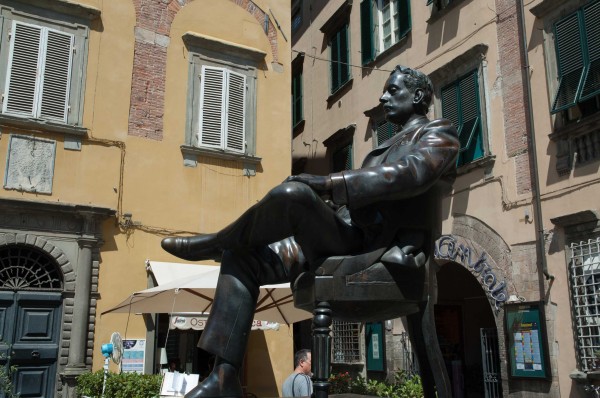 No one listens to “o mio babbino caro,” Turandot’s “nessun dorma” or Tosca’s “vissi d’arte” without reliving a piercing heartache. Each summer the outdoor Grand Teatro Puccini fills to capacity as successive generations of music lovers fall under the Puccini spell. Most composers’ popularity fades soon after their deaths. Not so with Puccini. If you wish to discover the surprising wellspring of his genius, visit Puccini’s haunts in and around Lucca.
No one listens to “o mio babbino caro,” Turandot’s “nessun dorma” or Tosca’s “vissi d’arte” without reliving a piercing heartache. Each summer the outdoor Grand Teatro Puccini fills to capacity as successive generations of music lovers fall under the Puccini spell. Most composers’ popularity fades soon after their deaths. Not so with Puccini. If you wish to discover the surprising wellspring of his genius, visit Puccini’s haunts in and around Lucca.
His operas occur in Paris, Rome, Japan, China, California; but Puccini barely strayed 20 miles from his birthplace. Within a small area, he lived life on an operatic scale.
In Celle
Celle, the hilltop village where the Puccini family spent summers, opens to chapter one. The excursion is as pleasant today as it was for the child Giacomo. The village resembles the pastoral setting in Edgar, Puccini’s first financial success. From the profits, Puccini regained ownership of his ancestral home, now the Celle Puccini Museum. 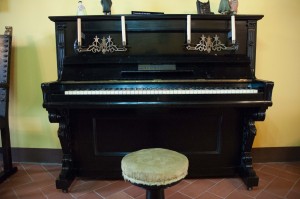
Glass cases display drafts of Le Villi and Edgar as well as opera compositions by his great-great grandfather, his grandfather and his father. Love and music entwined in this household of accomplished musicians. Giacomo practiced his lessons in the upstairs bedroom, one hand on the harmonium bellows, the other flitting over wooden keys.
In Lucca
Giacomo’s music training continued at Lucca’s San Martino Cathedral school (Piazza Antelminelli). Tosca echoes the religious festivals in which Puccini participated as a soloist, chorister and later as the assistant organist. Similar to his forefathers, he held the organist post at San Paolino Church (Via San Paolino).
The cobblestones he skipped he now took in long strides to Caffe di Simo (Via Fillungo, 58) where his artistic aspirations flourished among other young musicians, poets, painters and philosophers. If it’s open, sit over an afternoon espresso. Even today, the cafe oozes the atmosphere of La Bohéme. “I lived that Bohème,” Puccini reflected, “when there wasn’t yet any thought stirring in my brain of seeking the theme of an opera.” During his impoverished student days at the Milan Conservatory, Puccini pawned his possessions to pay the rent. In La Bohéme, the friends sell earrings and an overcoat to buy medicine for the ailing Mimi.
 The success of a revised version of Edgar at Teatro di Giglio (Piazza del Giglio) in 1891 did more than just improve his finances. The operatic world took him to its bosom. The Puccini Museum (Corte San Lorenzo, 9)—the home he once shared with his sisters and mother —overflows with letters, notes, family photos, awards and music. The atmosphere crackles with tension from a 1950s Madame Butterfly recording of Maria Callas singing “con onor muore.”
The success of a revised version of Edgar at Teatro di Giglio (Piazza del Giglio) in 1891 did more than just improve his finances. The operatic world took him to its bosom. The Puccini Museum (Corte San Lorenzo, 9)—the home he once shared with his sisters and mother —overflows with letters, notes, family photos, awards and music. The atmosphere crackles with tension from a 1950s Madame Butterfly recording of Maria Callas singing “con onor muore.”
Opera scores, set drawings and costumes convey the sensation caused by a new Puccini opera. Sopranos and tenors vied for roles. Designers conjured dazzling sets and costumes. Princess Turandot’s ensemble from the 1926 premiere at the Met hangs in a glass case. The heroine towered over her suitors in a tasseled multitiered headpiece and black velvet cape stitched with silver dragons.
The opposite case contains Puccini’s wool overcoat and the black fedora that he wore cocked at an angle. The glitz and glamor suited him. A bronze statue of Puccini (Piazza San Lorenzo) shows the maestro in his prime, seated and taking his pleasure, a Toscana cigarette in hand. 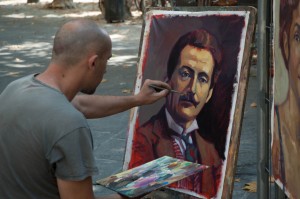
Puccini is a favorite subject among the oil painters at work on their canvases under the sycamore trees in Piazza del Giglio. It takes a practiced hand to capture the sensuality of Puccini’s heavy-lidded eyes.
Entwined in his creative process were amourettes, numerous affairs with women who resembled his heroines in spirit and character. At Ristorante Puccini (Corte San Lorenzo, 1) the Buonasera players enact a skit of Puccini wooing a new muse. You don’t need a translation.
Ardent declarations of love make stirring music. In 1884, he began an affair with Elvira, his piano student who was the wife of a prominent businessman. Discussing his opera Manon Lescaut with his music publisher, Puccini declared, “I shall feel it as an Italian, with desperate passion.” The couple attempted to live openly in Lucca, but the Lucchesi shamed them into fleeing.
In 1884, he began an affair with Elvira, his piano student who was the wife of a prominent businessman. Discussing his opera Manon Lescaut with his music publisher, Puccini declared, “I shall feel it as an Italian, with desperate passion.” The couple attempted to live openly in Lucca, but the Lucchesi shamed them into fleeing.
In Torre del Lago
Puccini wrote his major operas at his lakeside villa 12 miles from Lucca (Villa Museo Puccini, Torre del Lago). His pastimes and pleasures are evident: Steinway piano, guns, cars. He hunted ducks in the reeds of Lake Massaciuccoli then drove his glossy black Packard to a cafe in Lucca or Viareggio.
Accidents and tragedies influenced his creative process. His chauffeur in 1904 drove the family car off the road. Puccini’s leg was fractured so severely that he was incapacitated for a year. He completed Madame Butterfly during the long convalescence, boasting that pain could not stop him.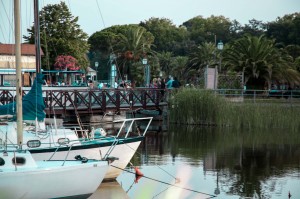
In 1909 an innocent girl’s suicide echoed the tragic end of Madame Butterfly, Tosca, and Turandot. Legally married since the death of Elvira’s husband in 1904, Puccini engaged the household maid to deliver love letters to Giulia Manfredi who worked at her father’s lakefront restaurant (Ristorante Chalet del Lago, Torre del Lago). Suspecting infidelity, his jealous wife tormented the maid to suicide. This affair remained secret until 2008 when their love letters were discovered. Giulia was the muse and bore a striking resemblance to Minnie in La Fanciulla del West.
Puccini composed heart-wrenching farewells as his heroines faced death. But upon his own death in 1924 from throat cancer, he penned six words, “Poor Elvira, this is the end.”
Thousands filed past his casket in Milan cathedral to Edgar’s resounding funeral procession. In Act III Filelia bids farewell to Edgar, her sweet love in “addio, mio dolce amor,” beseeching him to wait for her in heaven. Her pleas, as you know, fall on an empty casket, for her lover listens behind a curtain.
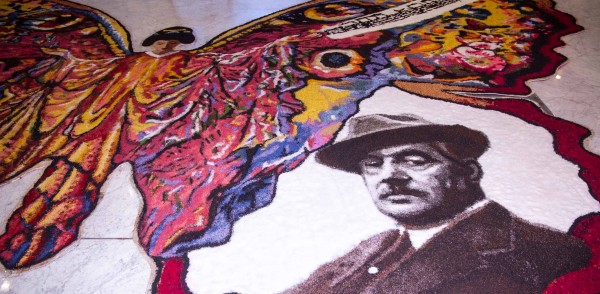
At the Puccini Opera Festival
Gran Teatro Puccini is a short walk from the Villa Puccini chapel where the maestro rests in his tomb. As starlight shimmers on Lake Massaciuccoli, the audience takes their seats. In an emotionally charged performance of Madame Butterfly, Coco San unleashes her unbearable pain singing “con onor muore” death with honor, and plunges a sword in her breast.
People exit quietly. A few faces—tear-streaked and radiant—betray a personal epiphany. If Puccini were watching behind a curtain, the words on his lips would be from Tosca’s “vissi d’arte.” “I gave my song to the stars, to heaven, which smiled with more beauty.”
—text and photography by Donna Peck

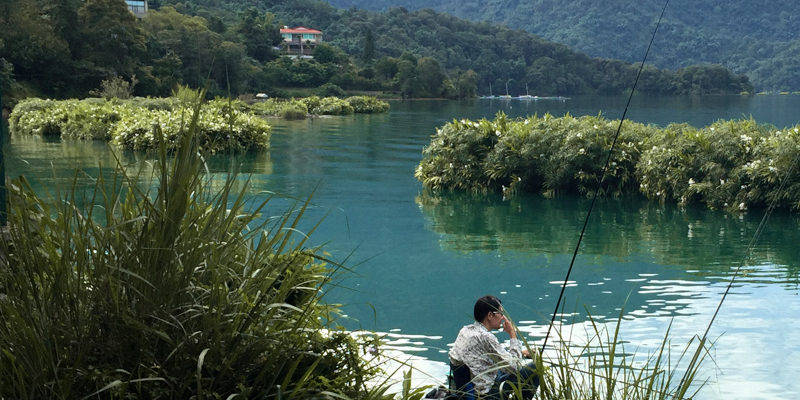
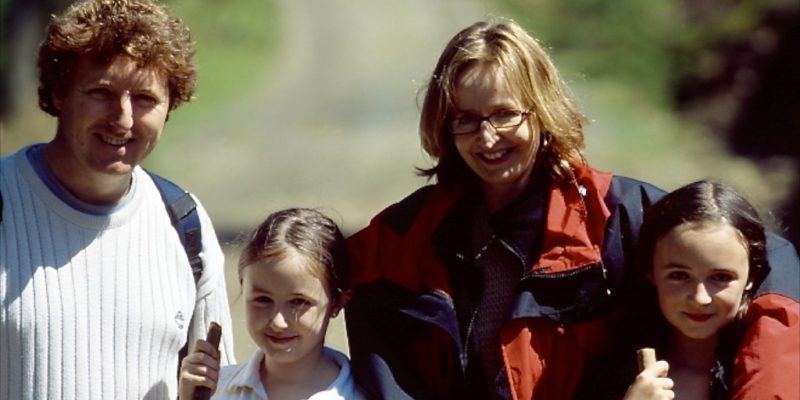

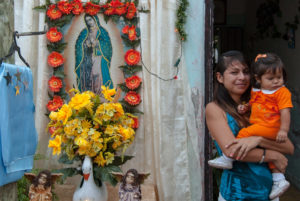

Leave a Reply